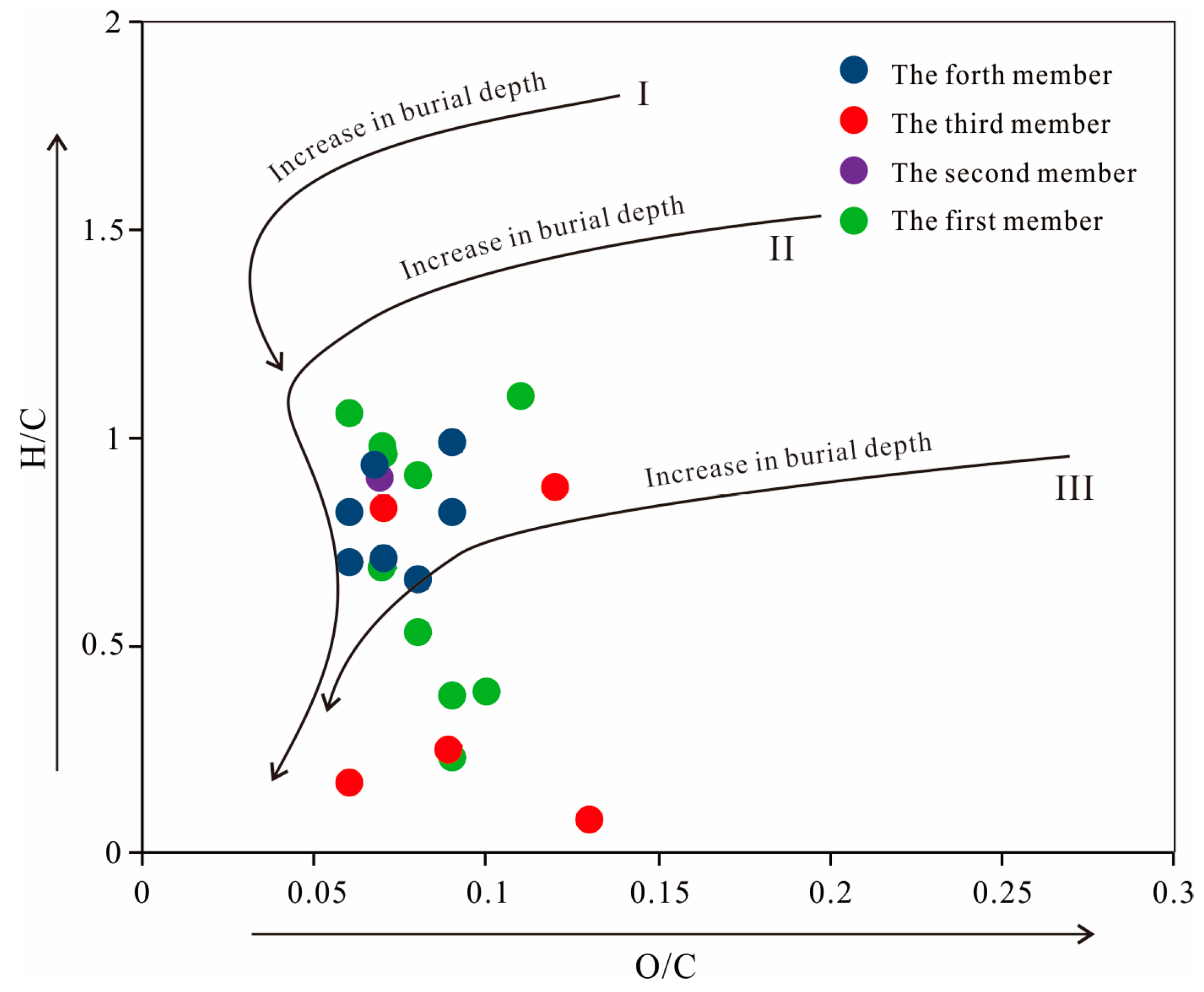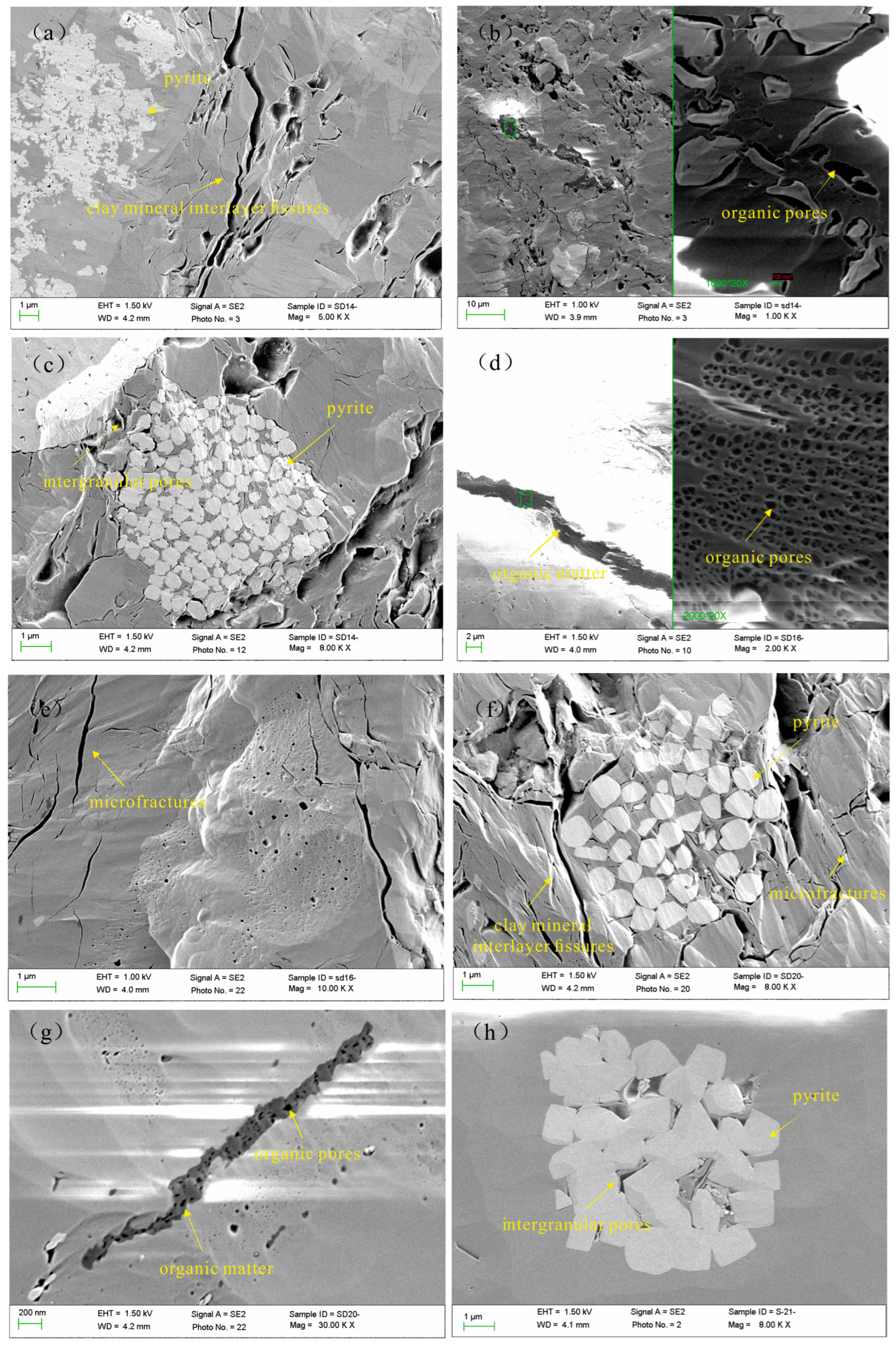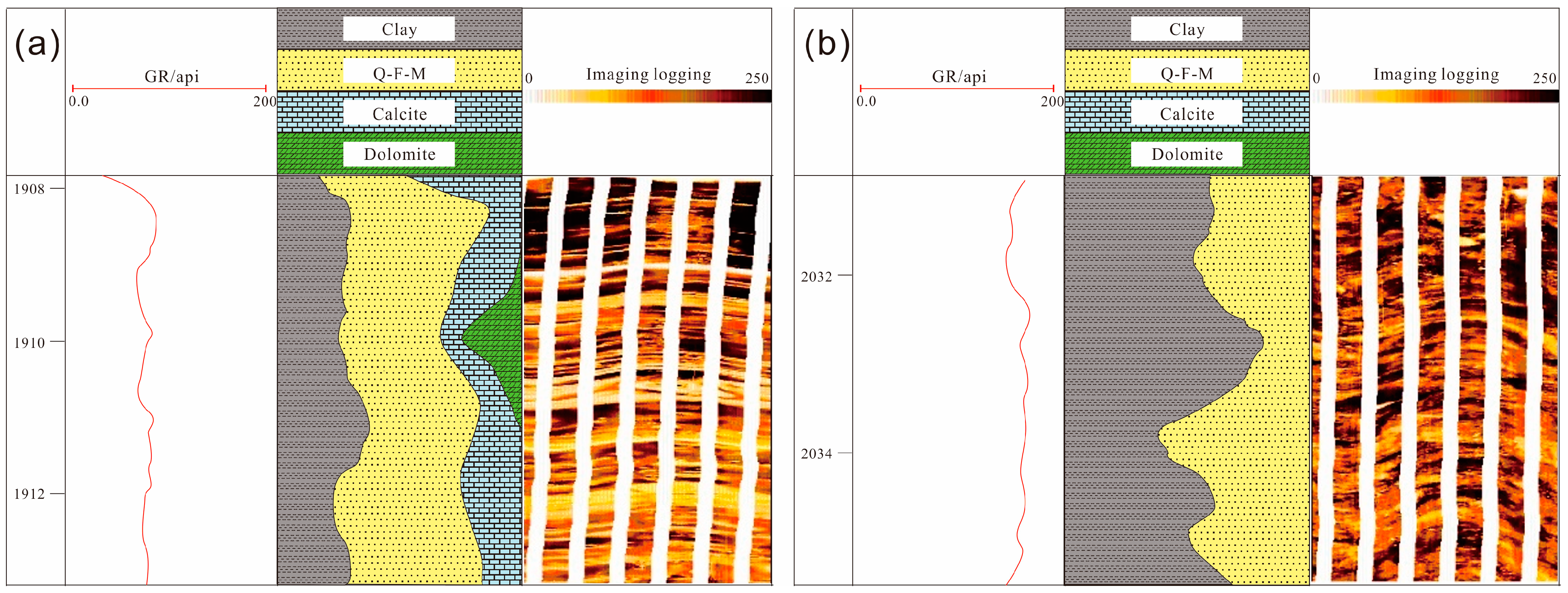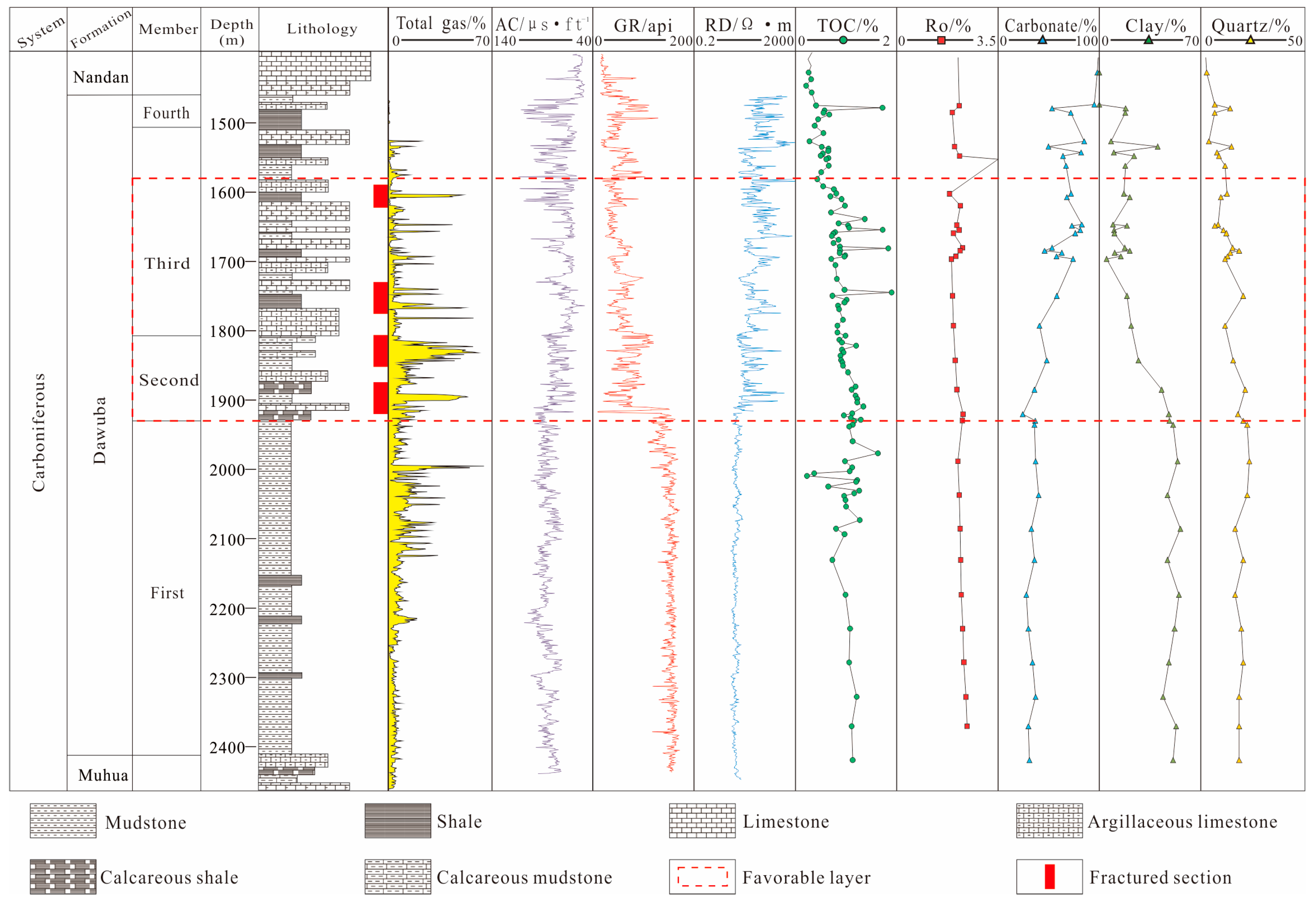Carboniferous Shale Gas Accumulation Characteristics and Exploration Directions in South China
Abstract
1. Introduction
2. Geological Setting
3. Samples and Experimental Methods
3.1. Samples
3.2. Mineral Composition Analysis
3.3. Geochemical Characteristics Analysis
3.4. Pore Microstructure Observation
3.5. Full Pore Size Characterization
3.6. Gas Content Analysis
4. Results
4.1. Mineral Composition Characteristics
4.2. Organic Geochemical Characteristics
4.3. Characterization of Pores
4.4. Porosity
4.5. Gas-Bearing Characteristics
5. Discussion
5.1. Comprehensive Evaluation of Shale in Dawuba Formation of Lower Carboniferous
5.2. Investigation Direction of Upper Paleozoic Marine Shale Gas in South China
6. Conclusions
- (1)
- The Lower Carboniferous Dawuba Formation in QSD-1 well has yielded a significant amount of shale gas, with a daily production of 11,011 m3. This breakthrough confirms the hydrocarbon generation potential of the Lower Carboniferous shale and identifies a new set of high-quality shale gas reservoirs that are different from the Wufeng-Longmaxi Formation. This discovery suggests that the YZLA may become a substantial area for shale gas industrialization and commercialization in the Yunnan-Guizhou-Guangxi region of South China.
- (2)
- The Lower Carboniferous Dawuba Formation has favorable conditions for the formation of large-scale shale gas reservoirs due to the following reasons: Firstly, the Dawuba Formation has a stable development and a large thickness. Secondly, the kerogen type of Dawuba Formation shale is primarily Type II-III, with an organic carbon content ranging from 0.25% to 1.42% and thermal evolution degree ranging from 1.92% to 2.57%. Thirdly, the study area’s thrust and reverse thrust structures in the compressional environment, affected by the Yanshan and Himalayan movements, are favorable for the formation of near-source gas reservoirs, which are advantageous for shale gas preservation. Fourthly, the static index elements of the Dawuba Formation match well, and the dynamic evolution in some areas is conducive to the large-scale aggregation of hydrocarbons. Finally, the development of synclines and anticlines with favorable overlying strata sealing conditions provides a good preservation environment for the formation of large gas fields.
- (3)
- The YZLA in South China offers three promising directions for the exploration of Carboniferous shale: ① The Weining-Liupanshui area in the northwestern part is a realistic field for increasing reserves; ② the Ziyun-Changshun area in the eastern part of the YZLA is a favorable location for exploring shale gas in the Lower Carboniferous formation; ③ the Rongshui-Huanjiang area in Guangxi Province presents favorable prospects for shale gas exploration. The Lower Carboniferous Luzhai Formation displayed tremendous potential for exploring new shale gas resources, promoting it as an ideal location for the exploration and development of China’s shale gas resources. Although Lower Carboniferous shale presents an encouraging exploration potential, a deeper comprehension and appraisal of the shale gas potential in this geological formation are necessary with more expertise.
- (4)
- The shale from the Carboniferous differs significantly from the shale from the Wufeng-Longmaxi Formation. The Carboniferous shale contains interbedded limestone and marl layers, which have a good match with organic matter, resulting in high methane content and indicating the combined control of limestone interbedded preservation conditions and organic matter on the adsorbed gas volume. This new type of shale gas in South China shows promising potential and warrants further exploration and research.
Author Contributions
Funding
Data Availability Statement
Acknowledgments
Conflicts of Interest
References
- Curtis, J.B. Fractured shale-gas systems. AAPG Bull. 2002, 86, 1921–1938. [Google Scholar]
- Nie, H.K.; Tang, X.; Bian, R.K. Controlling factors for shale gas accumulation and prediction of potential development area in shale gas reservoir of South China. Acta Pet. Sin. 2009, 30, 484–491. [Google Scholar]
- Dong, D.Z.; Zou, C.N.; Li, J.Z.; Wang, S.J.; Li, X.J.; Wang, Y.M.; Huang, J.L. Resource potential, exploration and development prospect of shale gas in the whole world. Geol. Bull. China 2011, 30, 324–336. [Google Scholar]
- Srinivasan, S.; O’Malley, D.; Mudunuru, M.K.; Sweeney, M.R.; Hyman, J.D.; Karra, S.; Viswanathan, H.S. A machine learning framework for rapid forecasting and history matching in unconventional reservoirs. Sci. Rep. 2021, 11, 21730. [Google Scholar] [CrossRef] [PubMed]
- Bernard, S.; Horsfield, B.; Schulz, H.M. Geochemical evolution of organic-rich shales with increasing maturity:a STXM and TEM study of the Posidonia shale (Lower Toarcian, northern Germany). Mar. Pet. Geol. 2012, 31, 70–89. [Google Scholar] [CrossRef]
- Scott, L.M.; Daniel, M.J.; Kent, A.B. Mississippian Barnett shale, Fort Worth Basin, north-central Texas: Gas-shale play with multitrillion cubic foot potential. AAPG Bull. 2005, 89, 155–175. [Google Scholar]
- Mastalerz, M.; Schimmelmann, A.; Drobniak, A. Porosity of Devonian and Mississippian New Albany shale across a maturation g gradient: Insights from organic petrology, gas adsorption, and mercury intrusion. AAPG Bull. 2013, 97, 1621–1643. [Google Scholar] [CrossRef]
- Yuan, K.; Huang, W.H.; Chen, X.L.; Cao, Q.; Fang, X.X.; Lin, T.; Jin, C.S.; Li, S.Z.; Wang, C.; Wang, T. The whole-aperture pore structure characteristics and their controlling factors of the Dawuba Formation shale in Western Guizhou. Processes 2022, 10, 622. [Google Scholar] [CrossRef]
- Li, X.F.; Yuan, K.; Fang, X.X.; Wang, T. Carbon and oxygen isotope composition of carbonate minerals in carbonaceous shale and its geological significance—A case study from the Carboniferous Dawuba Formation shale, southern Guizhou area China. Fresenius Environ. Bull. 2022, 31, 990–997. [Google Scholar]
- Mei, M.X.; Ma, Y.S.; Deng, J.; Chu, H.M.; Liu, Z.R. Carboniferous to Permian sequence stratigraphic framework of the Yunnan-Guizhou-Guangxi basin and its adjacent areas and global correlation of third-order sea-level change. Geol. China 2005, 32, 13–24. [Google Scholar]
- Xia, B.D.; Liu, H.L.; Wu, Y.G.; Yang, H.M. The Yunnan-Guizhou-Guangxi rist system. Pet. Geol. Exp. 1992, 14, 20–30. [Google Scholar]
- Yuan, K.; Chen, R.; Lin, T.; Fang, X.; Qin, Y.; Wang, C.; Center, G.S. Petrological characteristics and sedimentary environment in the southern Guizhou during the Late Carboniferous. Pet. Geol. Exp. 2019, 41, 38–44. [Google Scholar]
- Yuan, K.; Wang, C.; Qin, Y.; Yu, S.; Chen, R.; Shi, D.; Zhou, Z. The discovery of Carboniferous shale gas in Qianziye-1 well of Qianan (southern Guizhou) depression. Geol. China 2017, 44, 1253–1254. [Google Scholar]
- Wang, Y.F.; Zhai, G.Y.; Liu, G.H.; Shi, W.Z.; Lu, Y.C.; Li, J.; Zhang, Y.X. Geological characteristics of shale gas in different strata of marine facies in South China. J. Earth Sci. 2021, 32, 725–741. [Google Scholar] [CrossRef]
- Xia, W.C.; Zhou, J.; Lei, J.X.; Zhang, N.M.; Peng, Y. The evolution of the rifted oceanic basin due to lithosperic stretching in Yunnan-Guizhou and Guangxi provinces during the late Hercynian to middle Indosinian stage. Acta Geol. Sin. 1995, 69, 97–112. [Google Scholar]
- Loucks, R.G.; Reed, R.M.; Ruppel, S.C. Spectrum of pore types and networks in mudrocks and a descriptive classification for matrix-related mudrock pores. AAPG Bull. 2012, 96, 1071–1098. [Google Scholar] [CrossRef]
- Lin, T.; Yuan, K.; Chen, X.L.; Wang, S.J.; Jin, C.S.; Wang, C. Industrial gas flow of Carboniferous shales in southern China was obtained in Well Qianshuidi 1 in Guizhou Province. Geol. China 2022, 49, 995–997. [Google Scholar]
- Jia, C.Z.; Pang, X.Q.; Song, Y. The mechanism of unconventional hydrocarbon formation: Hydrocarbon self-containment and intermolecular forces. Pet. Explor. Dev. 2021, 48, 437–452. [Google Scholar] [CrossRef]
- Liu, G.; Zhai, G.; Zou, C.; Huang, Z.; Liu, B.; Guo, X.; Wang, H. Amorphous silica and its effects on shale reservoir: A case study about Yanchang formation lacustrine shale, Ordos Basin. Energy Sources Part A Recovery Util. Environ. Eff. 2018, 41, 975–989. [Google Scholar] [CrossRef]
- Yang, H.Y.; Chen, S.Y.; Hao, X.L.; Guo, H.; Li, C.; Yang, Y. Sedimentary characteristics and evolutionary stages of Late Paleozoic Longlin isolated platform in Nanpanjiang depression. Geol. China 2010, 37, 1638–1646. [Google Scholar]
- Yuan, K.; Huang, W.H.; Fang, X.X.; Wang, T.; Lin, T.; Chen, R. Evaluation of favorable shale gas intervals in Dawuba Formation of Ziyun Area, South Qian Depression. Geofluids 2021, 2021, 6688141. [Google Scholar] [CrossRef]
- Liu, J.P.; Ma, J.; Wang, X.W. Characteristics of the segments of the Ziyun deformation belt in the Nanpanjiang area, Guizhou, China. J. Chengdu Univ. Technol. (Sci. Technol. Ed.) 2006, 33, 15–18. [Google Scholar]
- Yang, Q.; Mao, Z.; Shao, M.R. Research methods and prospects of nanopore structure in shale gas reservoirs. Energy Chem. Ind. 2021, 42, 7–13. [Google Scholar]
- Milliken, K.L.; Rudnicki, M.; Awwiller, D.N. Organic matter-hosted pore system, Marcellus Formation (Devonian), PennsylvaniaJ. AAPG Bull. 2013, 97, 177–200. [Google Scholar] [CrossRef]
- Zou, C.N.; Zhao, Q.; Cong, L.Z.; Wang, H.Y.; Shi, Z.S.; Wu, J.; Pan, S. Development progress, potential and prospect of shale gas in China. Nat. Gas Ind. 2021, 41, 1–14. [Google Scholar]
- Liu, G.H.; Zhai, G.; Yang, R.; He, T.; Wei, B. Quartz crystallinity index: New quantitative evidence for biogenic silica of the Late Ordovician to Early Silurian organic-rich shale in the Sichuan Basin and adjacent areas, China. Sci. China Earth Sci. 2021, 64, 773–787. [Google Scholar] [CrossRef]
- Li, H.; Liu, A.; Luo, S.; Chen, X.; Chen, L. Characteristics of the Cambrian Shuijingtuo shale reservoir on Yichang slope, western Hubei Province: A case study of well EYY-1. Pet. Geol. Exp. 2019, 41, 76–82. [Google Scholar] [CrossRef]
- Cheng, G.F.; Xu, A.Q. An insight into the northwestern-trending tectonical deformation of the Weining-Ziyun belt, western Guizhou. Guizhou Geol. 1998, 15, 311–320. [Google Scholar]
- Yang, Y.R.; Liu, X.C.; Zhang, H.; Zhai, G.Y.; Zhang, J.D.; Hu, Z.F.; Bao, S.J.; Zhang, C.; Wang, X.H.; Yang, X.; et al. A review and research on comprehensive characterization of microscopic shale gas reservoir space. China Geol. 2019, 2, 541–556. [Google Scholar] [CrossRef]
- Ma, K.; Pang, H.; Zhang, L.; Huang, S.; Huo, X.; Chen, J. Hydrocarbon dynamic field division and its relevance to oil and gas exploration for Paleogene reservoir in Lufeng depression. Adv. Geo-Energy Res. 2022, 6, 415–425. [Google Scholar] [CrossRef]
- Wang, X.W.; Guo, T.L.; Wo, Y.J.; Zhou, Y.; Wu, L.Z.; Zhang, R.Q.; Li, S.J. Characteristics of deep structural segmentation and transformation of the Yaziluo fault zone. Oil Gas Geol. 2013, 34, 220–228. [Google Scholar]
- Wang, S.Y.; Zhang, H.; Wang, T.H.; Wang, C.H.; Peng, C.L.; Hu, R.F.; Chen, M.H.; Shi, L. Filling and evolution of the Late Paleozoic Shuicheng-Ziyun aulacogen in western Guizhou, China. Geol. Bull. China 2006, 25, 402–407. [Google Scholar]
- Wang, S.Y. Faults and earthquakes in Guizhou. J. Geomech. 2016, 22, 430–438. [Google Scholar]
- Yuan, K.; Fang, X.X.; Lin, T.; Bao, S.J.; Shi, D.S.; Zhang, C. Geochemical features and sedimentary conditions of Middle-Devonian shale in the northwestern central Guangxi depression. Geol. Explor. 2017, 53, 179–186. [Google Scholar]
- Peng, J.; Chen, H.D.; Tian, J.C.; Qin, J.X.; Hou, Z.J.; Yang, X.N.; Shou, J.F.; Shen, A.J.; Chen, Z.K. Sequence stratigraphy study on the Cabroniferous strata in Sichuan, Yunnan, Guizhou and Guangxi. Acta Sedimentol. Sin. 2000, 18, 190–197. [Google Scholar]
- Xu, Z.Y.; Yao, G.S.; Guo, Q.X. Genetic interpretation about geotectonics and structural transfiguration of the southern Guizhou depression. Geotecton. Et Metallog. 2010, 34, 20–31. [Google Scholar]
- Bernard, S.; Wirth, R.; Schreiber, A. Formation of nanoporous pyrobitumen residues during maturation of the Barnett shale (Fort Worth Basin). Int. J. Coal Geol. 2012, 103, 3–11. [Google Scholar] [CrossRef]
- Xie, X.Y.; Tang, H.M.; Wang, C.H.; Bai, R.; Wang, Z.L. Contrast of nitrogen adsorption method and mercury porosimetry method in analysis of shale’s pore size distribution. Nat. Gas Ind. 2006, 26, 100–102. [Google Scholar] [CrossRef]
- Tian, H.; Zhang, S.C.; Liu, S.B.; Zhang, H. Determination of organic-rich shale pore features by mercury injection and gas adsorption methods. Acta Pet. Sin. 2012, 33, 419–427. [Google Scholar]
- Dong, T.; Harris, N.B.; Ayranci, K.; Yang, S. The impact of rock composition on geomechanical properties of a shale formation: Middle and Upper Devonian Horn River Group shale, Northeast British Columbia, Canada. AAPG Bull. 2017, 101, 177–204. [Google Scholar] [CrossRef]
- Yang, X.; Jiang, Z.X.; Song, Y.; Huang, H.X.; Tang, X.L.; Ji, W.M. A Comparative Study on Whole-aperture Pore Structure Characteristics between Niutitang and Longmaxi Formation of High-matruity Marine Shales in Southeastern Chongqingelt. Geol. J. China Univ. 2016, 22, 368–377. [Google Scholar]
- Xie, Z.T.; Hu, H.Y.; Yuan, H.P.; Liu, J.P.; Wang, T.; Liu, L.H. Influence of shale components on the pore development differences between wufeng-longmaxi formation and Niutitang formation: A Case Study of JY-1 Well in Southeast Chongqing and CY-1 Well in Northwest Hunan. Geol. Resour. 2021, 30, 143–152. [Google Scholar]
- Li, F.J.; Zheng, R.C.; Zhou, X.J.; Zhao, J.X.; Jiang, B. Late Palaeozoic tectonic evolution and basin prototype in southern China. Sediment. Geol. Tethyan Geol. 2009, 29, 93–99. [Google Scholar]
- Loucks, R.G.; Reed, R.M.; Ruppel, S.C. Morphology, genesis, and distribution of nanometer-scale pores in siliceous mudstones of the Mississippian Barnett shale. J. Sediment. Res. 2009, 79, 848–861. [Google Scholar] [CrossRef]
- Modica, C.J.; Lapierre, S.G. Estimation of kerogen porosity in source rocks as a function of thermal transformation: Example from the Mowry shale in the Powder River Basin of Wyoming. AAPG Bull. 2012, 96, 87–108. [Google Scholar] [CrossRef]
- Liu, G.; Huang, Z.; Jiang, Z.; Chen, J.; Chen, F.; Xing, J. Gas adsorption capacity calculation limitation due to methane adsorption in low thermal maturity shale: A case study from the Yanchang Formation, Ordos Basin. J. Nat. Gas Sci. Eng. 2016, 30, 106–118. [Google Scholar] [CrossRef]
- Zhao, M.J.; Zhang, Y.C.; Zhao, L.; Liu, P.C. Oil and gas accumulation and gas exploration potential in the Nanpanjiang basin, China. Geol. Rev. 2006, 52, 642–649. [Google Scholar]
- Mastalerz, M.; Drobniak, A.; Stankiewicz, A.B. Origin, properties, and implications of solid bitumen in source-rock reservoirs:a review. Int. J. Coal Geol. 2018, 195, 14–36. [Google Scholar] [CrossRef]
- Yuan, K.; Wang, K.Y.; Gong, S.H.; Qin, Y.L.; Lu, S.F.; Chen, R.; Fang, X.X. Shale Gas Enrichment Features and Impacting Factors in Carboniferous Dawuba Formation, Southern Guizhou Area. Coal Geol. China 2018, 30, 28–34. [Google Scholar]
- Li, S.W. The effect analyses and aspects of petroleum exploration in Yunnan-Guizhou-Guangxi region. Oil Gas Geol. 1985, 6, 221–225. [Google Scholar]
- Landis, C.R.; Castano, J.R. Maturation and bulk chemical properties of a suite of solid hydrocarbons. Org. Geochem. 1995, 22, 137–149. [Google Scholar] [CrossRef]
- Ji, L.; Qiu, J.; Xia, Y.; Zhang, T. Micro-pore characteristics and methane adsorption properties of common clay minerals by electron microscope scanning. Acta Pet. Sin. 2012, 33, 249–256. [Google Scholar]
- Zeng, Y.F.; Liu, W.J.; Chen, H.D.; Zheng, R.C.; Zhang, J.Q.; Li, X.Q.; Jiang, T.C. The sedimentary characteristics and structural evolution of the Youjiang composite basin. Guangxi Geol. 1992, 5, 1–14. [Google Scholar]
- Chen, H.D.; Zhang, J.Q.; Liu, W.J. Structure of Youjiang basin in Devonian-Carboniferousperiod and its evolution of lithofaciesand palaeogeography. Guangxi Geol. 1994, 7, 15–23. [Google Scholar]
- Zheng, F.Z.; Tang, X.; Yuan, K.; Lin, T.; You, M.X.; Niu, J.L.; Zi, Y.Z.; Liang, Y.T. Sedimentation Models and Development Mechanisms of Organic-Rich Shales of the Lower Carboniferous Dawuba Formation: A Case Study in the Yaziluo Rift Trough, South of Guizhou Province, Southern China. ACS Omega 2022, 7, 29054–29071. [Google Scholar] [CrossRef]
- Ma, Y.S. Marine Oil and Gas Exploration in China; Springer Science and Business Media LLC: Berlin/Heidelberg, Germany, 2020. [Google Scholar]











| Sample | Depth/m | Member | Lithology | Sapropelinite/% | Vitrinite/% | Inertinite/% | Types Classification | |
|---|---|---|---|---|---|---|---|---|
| Normal Vitrinite | Fusinite | Index | Type | |||||
| S-1 | 1475.70 | Fourth | Black shale | 84.0 | 0.0 | 16.0 | 68.00 | II1 |
| S-2 | 1532.00 | Fourth | Black shale | 72.7 | 0.0 | 27.3 | 45.45 | II1 |
| S-3 | 1542.60 | Fourth | Black shale | 52.0 | 30.0 | 18.0 | 11.50 | II2 |
| S-4 | 1648.80 | Third | Black shale | 39.3 | 35.7 | 25.0 | −12.50 | III |
| S-5 | 1650.70 | Third | Black shale | 54.5 | 45.5 | 0.0 | 20.45 | II2 |
| S-6 | 1658.00 | Third | Black shale | 75.0 | 0.0 | 25.0 | 50.00 | II1 |
| S-7 | 1661.00 | Third | Black shale | 52.1 | 29.2 | 18.8 | 11.46 | II2 |
| S-8 | 1686.20 | Third | Black shale | 50.0 | 33.3 | 16.7 | 8.33 | II2 |
| S-9 | 1688.40 | Third | Black shale | 27.8 | 47.2 | 25.0 | −32.64 | III |
| S-10 | 1938.40 | Second | Black shale | 36.4 | 36.4 | 27.3 | −18.18 | III |
| Component | Concentration/% | Component | Concentration/% |
|---|---|---|---|
| Methane | 98.187 | Nitrogen | 0.560 |
| Ethane | 0.402 | Helium | 0.045 |
| Propane | 0.021 | Hydrogen | 0.001 |
| Carbon dioxide | 0.784 | - | - |
| Wufeng-Longmaxi Formation | Dawuba Formation | |
|---|---|---|
| Distribution area | Most of the middle and upper Yangtze region except the central and western Sichuan basin | Southern Guizhou Province, Guangxi Province, most of Hunan Province, and northeastern Yunnan Province |
| Shale thickness | 50–900 m, organic-rich shale 20–80 m | 60–1200 m, organic-rich shale 30–260 m |
| System | Upper Ordovician-Lower Silurian | Lower Carboniferous |
| Lithofacies characteristics | (1) organic-rich, siliceous bioshales; (2) black, fine-grained, oil-bearing biolimestone; (3) Siliceous shale is more brittle than clay-rich shale, and fractures are easier to develop. | (1) rhythmic interbedding of marl and shale with unequal thickness; (2) The first and third members of Dawuba Formation have developed foliation and high shale content; (3) The shale organic matter pores are not well developed. |
| Mineral composition | quartz: 18–70%, calcite: 3–11%, illite: 13–36%, chlorite: 3–28%, dolomite: 4–38%, feldspar: 3–10%, pyrite: 1–4%, gypsum: 1–2% | quartz: 4–27%, calcite:4–93%, illite: 5–70%, chlorite: 5–47%, feldspar: 1–3% |
| Sedimentary background | influenced by paleo-uplifts and passive continental margin rifting | a rift-type basin formed on the southern passive continental margin of the Yangtze Craton, with asymmetric features having steep northern and gentle southern slopes |
| Geological structure characteristics | Central Guizhou uplift, central Sichuan uplift, Motianling ancient land and Hannan ancient land | Yadu-Ziyun-Luodian aulacogen, Qiannan depression, Qianxinan depression, Nanpanjiang depression and Guizhong depression |
| Sedimentary environment | Detained deep water basin with distinct water body stratification and anoxic bottom water; In some areas, there are also areas connected with the wide sea, which leads to the local prosperity of marine radiolarians; Water depth is 100–300 m | The lithofacies palaeogeographic framework of the secondary deep-water basin and platform distributed alternately in NW direction and NE direction, and the sedimentary subfacies such as shore, platform, slope and basin are developed |
| Burial depth | 3–6 km | 0–5 km |
| TOC | 1–10%, the kerogen type is mainly type I | 0.5–5.2%, the kerogen type is mainly type II |
| Ro | Ro ≥ 1.6% (Up to 3.6%) | 2.0–3.0% (Up to 4.0%) |
Disclaimer/Publisher’s Note: The statements, opinions and data contained in all publications are solely those of the individual author(s) and contributor(s) and not of MDPI and/or the editor(s). MDPI and/or the editor(s) disclaim responsibility for any injury to people or property resulting from any ideas, methods, instructions or products referred to in the content. |
© 2023 by the authors. Licensee MDPI, Basel, Switzerland. This article is an open access article distributed under the terms and conditions of the Creative Commons Attribution (CC BY) license (https://creativecommons.org/licenses/by/4.0/).
Share and Cite
Yuan, K.; Huang, W.; Feng, B.; Li, L.; Li, S.; Fang, X.; Yang, X.; Xu, Q.; Chen, R.; Chen, X. Carboniferous Shale Gas Accumulation Characteristics and Exploration Directions in South China. Processes 2023, 11, 1896. https://doi.org/10.3390/pr11071896
Yuan K, Huang W, Feng B, Li L, Li S, Fang X, Yang X, Xu Q, Chen R, Chen X. Carboniferous Shale Gas Accumulation Characteristics and Exploration Directions in South China. Processes. 2023; 11(7):1896. https://doi.org/10.3390/pr11071896
Chicago/Turabian StyleYuan, Kun, Wenhui Huang, Bing Feng, Long Li, Shizhen Li, Xinxin Fang, Xiaoguang Yang, Qiuchen Xu, Rong Chen, and Xianglin Chen. 2023. "Carboniferous Shale Gas Accumulation Characteristics and Exploration Directions in South China" Processes 11, no. 7: 1896. https://doi.org/10.3390/pr11071896
APA StyleYuan, K., Huang, W., Feng, B., Li, L., Li, S., Fang, X., Yang, X., Xu, Q., Chen, R., & Chen, X. (2023). Carboniferous Shale Gas Accumulation Characteristics and Exploration Directions in South China. Processes, 11(7), 1896. https://doi.org/10.3390/pr11071896









